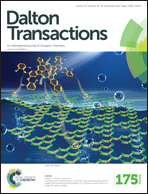Group 10–group 14 metal complexes [E–TM]IV: the role of the group 14 site as an L, X and Z-type ligand†
Abstract
A series of new complexes of a general motif [R2E(μ-N,S)2TM–L] (E: metalloid group 14 element; TM: group 10 metal; R: Cl, Ph, pyS, OH, (N,N,O)-chelating ligands; N,S: 1-methylimidazole-2-thiolate (methimazolyl, mt−), pyridine-2-thiolate (pyS−); L: PPh3, PCy3, pyS) was synthesised and characterised by single-crystal X-ray diffraction, multi-nuclear NMR spectroscopy (1H, 13C, 31P, 119Sn), 119Sn Mössbauer spectroscopy and quantum chemical calculations. The E–TM bonding situation in these compounds can be described with various resonance structures which comprise E(II)→TM(II), E(III)–TM(I) and E(IV)←TM(0) features. Thus, in these complexes the atoms of the group 14 based ligand sites reveal L-, X- and Z-type ligand characteristics. A systematic comparison between structural and spectroscopic parameters as well as the results from NLMO analyses of structurally related compounds provided information about the differences in the E–TM bonding situation upon alteration of the metal atoms or ligand patterns. Under investigation are the structurally related compounds [Cl2Sn(μ-pyS)2TM–PPh3] (1: TM = Pd; 2: TM = Ni; 3: TM = Pt), [Cl2Ge(μ-pyS)2Pd–PPh3] (4) and, for in silico analysis, [Cl2Si(μ-pyS)2Pd–PPh3] (5), which indicate a pronounced shift of the E–TM bond electron pair towards TM for TM = Pt. Further complexes serve as representatives of these compounds with different bridging ligands {[Cl2Sn(μ-mt)2Pd–PPh3] (8)}, different trans-E–TM-bound ligands {[Cl2Sn(μ-pyS)2Pd–PCy3] (9), [Cl2Sn(μ-pyS)2Pd]4 (10)} and with different substituents at Sn (including penta- and hexacoordinated tin compounds), i.e., [R2Sn(μ-pyS)2Pd–PPh3] with R = Ph (6) and pyS (7), [(O,N,N)Sn(μ-pyS)2Pd–PPh3] (11) and (12) having two different (O,N,N) tridentate ligands, and [(μ-OH)ClSn(μ-pyS)2Pd–PPh3]2 (13). The latter series indicates a shift of the E–TM (= Sn–Pd) bond electron pair towards Pd upon transition from penta- to hexacoordinated tin compounds.
![Graphical abstract: Group 10–group 14 metal complexes [E–TM]IV: the role of the group 14 site as an L, X and Z-type ligand](/en/Image/Get?imageInfo.ImageType=GA&imageInfo.ImageIdentifier.ManuscriptID=C6DT01621A&imageInfo.ImageIdentifier.Year=2016)

 Please wait while we load your content...
Please wait while we load your content...